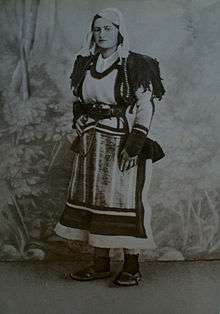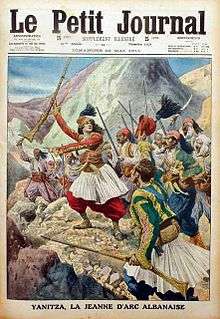Tringe Smajli
| Tringe Smajli | |
|---|---|
 Photo of Tringe Smajli | |
| Born |
1880 Grudë, Sanjak of Scutari, Ottoman Empire, (now in Montenegro) |
| Died |
2 November 1917 (aged 36–37) Grudë, Kingdom of Montenegro |
| Nationality | Albanian |
| Known for | Fighting Ottoman occupiers |
Tringë Smajl Martini Ivezaj (1880 – 2 November 1917), known simply as Tringe Smajli, and as Yanitza outside Albania, was an Albanian guerrilla fighter who fought against the Ottoman Empire in the Malësia region. She was the daughter of Smajl Martini, a Catholic clan leader of the Grudë tribe of Malësia.
Family
She was born in 1880.[1] Her father Smajl Martini was a Catholic clan leader of the Grudë tribe (located in southeastern Montenegro).[2] His signature shows up in the protest-petitions of northern Albanian tribes sent to European ambassadors and counsels accredited in the Ottoman Empire, i.e. the one of May 9, 1878 sent to French Ambassador in Istanbul, or the one of June 15, 1878. The petitions expressed the dismay and disapproval of the Albanian tribes to the decisions of the Treaty of San Stefano and Congress of Berlin, which had granted much of the Scutari Vilayet to the Principality of Montenegro.[3] She became very active during the League of Prizren, joining the rebels until the organization's end; she was later arrested in 1886, and imprisoned in Anatolia, from where she did never return. In addition, Smajl's two sons, Gjon and Zef, Tringe's brothers, also joined the League and were killed in battle in 1883.[3]
History
At the time of her brother's deaths, Tringe became a sworn virgin – she took a vow of chastity and wore male clothing in order to live as a man in the patriarchal northern Albanian society.
Tringe joined the rebels and distinguished herself in the Battle of Deçiq.[3] She participated in the Gërçe Memorandum, on June 23, 1911. Her rebel activity continued after the Albanian Declaration of Independence (28 November 1912).
She never married and never had children, as she had earlier taken the vow. She died in November 2, 1917, and was buried at the family burial grounds in the Gruda mountains within the village of Kshevë, in today's Montenegro. Two years later, the Montenegrin army (part of the Kingdom of Serbs, Croats and Slovenes) destroyed her grave while raiding the area.[3]
Legacy

Her heroism made her famous and was recorded in epic songs of Montenegrins and Albanians. The folkloric version of her heroism tells a slightly different chain of events: Smajl Martini, the clan leader was kidnapped in 1911 in Vranje by the Ottomans, and his body was never recovered, forcing Tringe to occupy her father's place.[4] Since the Malissori uprising of 1911 was backed up by King Nikola Petrović, the epic song excluded the real story of her father death, hiding any reminiscence of the League of Prizren period, which would bring back territorial disputes between Albanians and the Kingdom of Montenegro. Ironically, the conflict between Albanians and Montenegro would be repeated shortly after. In 1911, the New York Times described Tringe Smajli as the "Albanian Joan of Arc", based on the Montenegrin version of the story which was heard somewhere in Podgorica by the Times correspondent.[4] It describes Tringe as "a beautiful young woman" in addition to her heroism.
Her legend lives on throughout the Balkans as one of the most heroic women warriors in the history of the region.[5]
Several streets in Kosovo and Albania are named after her and is regarded a People's Hero of Albania.
See also
References
- ↑ Qemal Haxhihasani; Agron Xhagolli; Instituti i Kulturës Popullore (Akademia e Shkencave e RPS të Shqipërisë) (1985). Folklor kosovar. Akademia e Shkencave e RPS të Shqipërisë, Instituti i Kulturës Popullore. p. 1880.
- ↑ Edi Shukriu (2000). Gra të shquara shqiptare [Distinguished Albanian women] (in Albanian). 1. Prishtina: Teuta. p. 54. OCLC 630465842. Retrieved 2013-11-10.
- 1 2 3 4 Pollo, Stefanaq; Pulaha, Selami (1978). Akte te Rilindjes Kombëtare Shqiptare 1878-1912 : memorandume, vendime, protesta, thirrje [Acts of Albanian National Awakening 1878-1912: memos, decisions, protests, petiotions] (in Albanian). Tirana, Albania: Academy of Science of Albanian SPR, Institute of History. pp. 30–33, 37, 55–57, 92–93, 97–98, 100. OCLC 18832697.
- 1 2 "ALBANIAN JOAN OF ARC.; Handsome Heroine Takes Father's Place and Vanquishes Turks.", New York Times (PARTS III AND IV ed.), pp. C3, 1911-05-21, retrieved 2013-11-10
- ↑ Savez udruženja folklorista Jugoslavije. Kongres. (1980), Rad ... Kongresa Saveza folklorista Jugoslavije. (in Serbo-Croatian), Cetinje, Yugoslavia, p. 219, OCLC 8509246, retrieved 2013-11-10
Bibliography
- Martini, Luigj, 2005 Prek Cali, Kelmendi Dhe Kelmendasit ISBN 9994334077 Publisher: Camaj-Pipaj
- Uli, Prenk, 1969 Tringa of Gruda: biography of Tringe Smajli (Albanian: Tringa e Grudës : skicë jetëshkrimi e Tringë Smailes, 1870-1917) OCLC 24539756 Publisher: Shtëpia Botuese "Naim Frashëri", Tirana